Spatial–Temporal Heterogeneous Evolution of Haze Pollution in China as Deduced with the Use of Spatial Econometrics
Abstract
1. Introduction
2. Literature Review
3. Research Design
3.1. Research Methods and Model Construction
3.1.1. Spatial Weight Matrix
3.1.2. Spatial Autocorrelation
- Global spatial autocorrelation analysis. The overall correlation degree of cross-regional observation variables is measured by the global spatial autocorrelation index :where . The interval of is [−1,1], the absolute value represents the strength of correlation, and the signs represent the directional characteristics of spatial correlation.
- Local spatial autocorrelation. The indicators of Local Indicators of Spatial Association (LISA) are used to reveal the spatial similarity or correlation between different regions, as well as identify the spatial agglomeration and spatial isolation. As a special system of spatial effect, LISA are composed of local and local and mainly used to test whether local areas tend to agglomerate in space. Therefore, the distribution characteristics of local systems are analyzed by the index, Moran scatter plot, and LISA. Meanwhile, the scatter plots are used to describe the correlation between variables (horizontal axis) and spatial lag vectors (vertical axis). High-value areas in the first quadrant are surrounded by high-value areas (high–high); high-value areas in the second quadrant are surrounded by low-value areas (low–high); low-value areas in the third quadrant are surrounded by low-value areas (low–low); low-value areas in the fourth quadrant are surrounded by high-value areas (high–low).
3.1.3. Spatial Econometric Model
3.2. Indicators and Data
4. Haze Pollution Path, Spatio–Temporal Heterogeneity and Structural Distribution
4.1. Time Trends Development Characteristics of Haze Pollution
4.2. Spatial Correlation and Pattern of Haze Pollution
5. Spatial Econometric Analysis of the Effects of Diversified Factors on Haze Pollution Path Characteristics
6. Conclusions and Enlightenment
6.1. Research Conclusions
6.2. Enlightenment and Suggestions
Author Contributions
Funding
Acknowledgments
Conflicts of Interest
References
- Chen, L.L.; Zhang, X.D.; He, F.; Yuan, R.S. Regional green development level and its spatial relationship under the constraints of haze in China. J. Clean. Prod. 2019, 210, 376–387. [Google Scholar] [CrossRef]
- Liu, H.M.; Fang, C.L.; Huang, J.J.; Zhu, X.D.; Zhou, Y.; Wang, Z.B.; Zhang, T. Spatio-temporal characteristics and influencing factors of air pollution in Beijing-Tianjin-Hebei urban agglomeration. Acta Geogr. Sin. 2018, 73, 177–191. [Google Scholar]
- Leeuw, F.A.M.D.; Moussiopoulos, N.; Sahm, P.; Bartonova, A. Urban air quality in larger conurbations in the European Union. Environ. Model. Softw. 2001, 16, 399–414. [Google Scholar] [CrossRef]
- Liang, W.; Yang, M.; Li, X.G. Interaction between agglomeration and Urban Haze pollution. Urban Probl. 2017, 9, 85–95. [Google Scholar]
- Zhang, K.; Wang, D.F. Interaction between economic agglomeration and environmental pollution and spatial spillover. China Ind. Econ. 2014, 6, 70–82. [Google Scholar]
- Verhoef, E.T.; Nijkamp, P. Externalities in urban sustainability: Environment versus localization-type agglomeration externalities in a general spatial equilibrium model of a single-sector monocentric industrial city. Ecol. Econ. 2002, 40, 157–179. [Google Scholar] [CrossRef]
- Feldman, M.P. The New Economics of Innovation, Spillovers and Agglomeration: A review of Empirical Studies. Econ. Innov. New Tech. 1999, 8, 5–25. [Google Scholar] [CrossRef]
- Li, Q.; Song, J.P.; Zhang, J.H.; Yu, W.; Hu, H. Evolution of the Impact of Urbanization on Environmental Air Quality in China. Acta Sci. Circumst. 2013, 33, 2402–2411. [Google Scholar]
- Han, L. Construction and Measurement of Haze Disaster Risk Index. Stat. Decis. 2017, 2, 28–32. [Google Scholar]
- Han, L.H.; Xiang, X.; Zhang, H.L.; Cheng, S.Y.; Lang, J.L. Insights into submicron particulate evolution, sources and influences on haze pollution in Beijing, China. Atmos. Environ. 2019, 201, 360–368. [Google Scholar] [CrossRef]
- Zhang, B.Y.; Zhao, X.M.; Zhang, J.B. Characteristics of peroxyacetyl nitrate pollution during a 2015 winter haze episode in Beijing. Environ. Pollut. 2019, 244, 379–387. [Google Scholar] [CrossRef]
- Pan, Y.P.; Wang, Y.S.; Zhang, J.K.; Liu, Z.R.; Wang, Y.H. Redefining the importance of nitrate during haze pollution to help optimize an emission control strategy. Atmos. Environ. 2016, 141, 197–202. [Google Scholar] [CrossRef]
- Tao, M.H.; Chen, L.F.; Xiong, X.Z.; Zhang, M.G.; Wang, Z.F. Formation process of the widespread extreme haze pollution over northern China in January 2013: Implications for regional air quality and climate. Atmos. Environ. 2014, 98, 417–425. [Google Scholar] [CrossRef]
- Liu, D.Y.; Yan, W.L.; Kang, Z.M.; Liu, A.N.; Zhu, Y. Boundary-layer features and regional transport process of an extreme haze pollution event in Nanjing, China. Atmos. Pollut. Res. 2018, 9, 1088–1099. [Google Scholar] [CrossRef]
- He, J.J.; Gong, S.L.; Zhou, C.H.; Lu, S.H.; Yin, C.M. Analyses of winter circulation types and their impacts on haze pollution in Beijing. Atmos. Environ. 2018, 192, 94–103. [Google Scholar] [CrossRef]
- Zheng, Z.F.; Xu, G.R.; Yang, Y.J.; Wang, Y.T.; Li, Q.C. Statistical characteristics and the urban spillover effect of haze pollution in the circum-Beijing region. Atmos. Pollut. Res. 2018, 9, 1062–1071. [Google Scholar] [CrossRef]
- Cheng, X.G.; Richard, B.; Zhao, T.L.; Xu, X.D.; Shang, K. Climate modulation of Nio 3.4 SST-anomalies on air quality change in southern China: Application to seasonal forecast of haze pollution. Atmos. Res. 2019, 225, 157–164. [Google Scholar] [CrossRef]
- Li, T.Y.; Deng, X.J.; Li, Y.; Song, Y.S.; Wang, C.L. Transport paths and vertical exchange characteristics of haze pollution in Southern China. Sci. Total Environ 2018, 625, 1074–1087. [Google Scholar] [CrossRef]
- Zhang, L.; Guo, X.M.; Zhao, T.L.; Gong, S.L. A modelling study of the terrain effects on haze pollution in the Sichuan Basin. Atmos. Environ. 2019, 196, 77–85. [Google Scholar] [CrossRef]
- Liu, H.J.; Du, G.J. Spatial correlation study of haze pollution in China. Stat. Res. 2018, 319, 5–17. [Google Scholar]
- Wang, C.C.; Wang, Y.C.; Ma, R.F.; Wang, J.M. Spatial Econometric Study on the Impact of Economic Agglomeration on Haze Pollution: A Case Study of the Yangtze River Delta. Res. Environ. Yangtze Bas. 2019, 28, 1–11. [Google Scholar]
- Liu, H.J.; Pei, Y.F. Environmental Kuznets Curve Test of Haze Pollution in China. Stat. Res. 2017, 3, 47–56. [Google Scholar]
- Du, G.; Liu, S.Z.; Lei, N.; Huang, Y. A test of environmental Kuznets curve for haze pollution in China: Evidence from the penal data of 27 capital cities. J. Clean. Prod. 2018, 205, 821–827. [Google Scholar] [CrossRef]
- Hui, L.R.; Liu, X.G.; Tan, Q.W.; Feng, M.; Cheng, N.L. VOC characteristics, sources and contributions to SOA formation during haze events in Wuhan, Central China. Sci. Total Environ. 2019, 650, 2624–2639. [Google Scholar] [CrossRef]
- Yin, S.; Wang, X.F.; Zhang, X.R.; Zhang, Z.X.; Sun, Z.Y. Exploring the effects of crop residue burning on local haze pollution in Northeast China using ground and satellite data. Atmos. Environ. 2019, 199, 189–201. [Google Scholar] [CrossRef]
- Hong, Y. Evaluation of regional haze level in China based on structural equation model. Stat. Decis. 2019, 35, 62–65. [Google Scholar]
- Tian, M.; Wang, Y.L. The relationship between industrial structure, energy consumption and the main components of haze—Take Beijing as an example. Econ. Pro. 2018, 467, 56–64. [Google Scholar]
- Wu, J.N.; Qin, C.; Zhang, P. Influencing factors of haze pollution: An empirical study based on monitoring PM2.5 concentration in cities in China. Admin. Tri. 2016, 23, 62–66. [Google Scholar]
- Sun, H.X.; Li, S. Spatial Coupling Relations of Atmospheric Haze with Coal Consumption and Environmental Taxation—Taking 31 Provinces and Regions in China as an Example. Inq. Econ. Iss. 2018, 1, 155–166. [Google Scholar]
- Liang, W.; Yang, M. Urbanization, economic growth and environmental pollution: Evidence from China. Sustain. Comput. Inform. Syst. 2019, 21, 1–9. [Google Scholar] [CrossRef]
- Yuan, M.; Huang, Y.P.; Shen, H.F.; Li, T.W. Effects of urban form on haze pollution in China: Spatial regression analysis based on PM2.5 remote sensing data. Appl. Geogr. 2018, 98, 215–223. [Google Scholar] [CrossRef]
- Huang, W.Q.; Fan, H.B.; Qiu, Y.F.; Cheng, Z.Y. Causation mechanism analysis for haze pollution related to vehicle emission in Guangzhou, China by employing the fault tree approach. Chemosphere 2016, 151, 9–16. [Google Scholar] [CrossRef] [PubMed]
- Huang, W.Q.; Fan, H.B.; Qian, Y. Modeling and efficient quantified risk assessment of haze causation system in China related to vehicle emissions with uncertainty consideration. Sci. Total Environ. 2019, 668, 74–83. [Google Scholar] [CrossRef] [PubMed]
- Li, H.; Duan, F.K.; Ma, Y.L.; He, K.B.; Kimoto, T. Case study of spring haze in Beijing: Characteristics, formation processes, secondary transition, and regional transportation. Environ. Pollut. 2018, 242, 544–554. [Google Scholar] [CrossRef] [PubMed]
- Zhang, M.; Li, H. New evolutionary game model of the regional governance of haze pollution in China. Appl. Math. Model. 2018, 63, 577–590. [Google Scholar] [CrossRef]
- Shen, L.; Wang, Y.Y. Supervision mechanism for pollution behavior of Chinese enterprises based on haze governance. J. Clean. Prod. 2018, 197, 571–582. [Google Scholar] [CrossRef]
- Jia, S.W.; Liu, X.L.; Yan, G.L. Effect of APCF policy on the haze pollution in China: A system dynamics approach. Energy Policy 2019, 125, 33–44. [Google Scholar] [CrossRef]
- Hsiao, Y.L.; Chen, Y.S. Pricing the haze option with the PM2.5 index. Asia Pac. Manag. Rev. 2019, 24, 27–36. [Google Scholar] [CrossRef]
- Norgaard, K.M. Cognitive and Behavioral Challenges in Responding to Climate Change. Policy Res. Work. Paper 2016, 4940, 76–85. [Google Scholar]
- Zhao, C.N.; Zhang, M.; Wang, W.W. Exploring the influence of severe haze pollution on residents’ intention to purchase energy-saving appliances. J. Clean. Prod. 2019, 212, 1536–1543. [Google Scholar] [CrossRef]
- Zhang, M.; Guo, S.; Bai, C.Y.; Wang, W.W. Study on the impact of haze pollution on residents’ green consumption behavior: The case of Shandong Province. J. Clean. Prod. 2019, 219, 11–19. [Google Scholar] [CrossRef]
- Guan, Y.M.; Li, P.; Jiao, Y. Property rights, haze pollution and low-carbon performance of enterprises. Jiangsu Soc. Sci. 2018, 296, 91–100. [Google Scholar]
- Dong, T.T. Study on the Interaction of Haze Pollution (PM2.5), Industrial Agglomeration and Industrial Efficiency. Soft Sci. 2016, 30, 26–30. [Google Scholar]
- Lin, L.; Zhu, X.; Jiang, G.R. The influence of haze on the growth rate of regional GDP: The mediating effect of depression. J. Psychol. Sci. 2018, 233, 117–122. [Google Scholar]
- Andersson, M.; Modig, L.; Hedman, L. Heavy vehicle traffic is related to wheeze among schoolchildren: A population-based study in an area with low traffic flows. J. Environ. Health 2011, 10, 91. [Google Scholar] [CrossRef]
- Leem, J.H.; Kaplan, B.M.; Shim, Y.K. Exposures to Air Pollutants during Pregnancy and Preterm Delivery. Environ. Health Perspect. 2006, 114, 905–910. [Google Scholar] [CrossRef]
- Briggs, D.J.; Elliott, P. The use of geographical information systems in studies on environment and health. World Health Stat. Q. 1995, 48, 85–94. [Google Scholar]
- Sorensen, M.; Hoffmann, B.; Hvidberg, M. Long-Term Exposure to Traffic-Related Air Pollution Associated with Blood Pressure and Self-Reported Hypertension in a Danish Cohort. Environ. Health Perspect. 2012, 120, 418–424. [Google Scholar] [CrossRef]
- Moore, D.K.; Jerrett, M.; Mack, W.J.; Künzli, N. A land use regression model for predicting ambient fine particulate matter across Los Angeles, CA. J. Environ. Monit. 2007, 9, 246–252. [Google Scholar] [CrossRef]
- Famoso, F.; Wilson, J.; Monforte, P.; Lanzafame, R.; Brusca, S.; Lulla, V. Measurement and modeling of ground-level ozone concentration in Catania, Italy using biophysical remote sensing and GIS. Int. J. Appl. Eng. Res. 2017, 12, 12. [Google Scholar]
- Wang, S.; Liao, T.T.; Wang, L.L.; Sun, Y. Process analysis of characteristics of the boundary layer during a heavy haze pollution episode in an inland megacity. China J. Environ. Sci. 2016, 40, 138–144. [Google Scholar] [CrossRef] [PubMed]
- Dong, F.; Zhang, S.N.; Long, R.Y.; Zhang, X.Y.; Sun, Z.Y. Determinants of haze pollution: An analysis from the perspective of spatiotemporal heterogeneity. J. Clean. Prod. 2019, 222, 768–783. [Google Scholar] [CrossRef]
- Lin, C.H. Spatial econometric analysis of haze pollution in China. Stat. Decis. 2018, 34, 94–99. [Google Scholar]
- Zhou, J.K.; Huang, J.; Zhang, Y.N. Main Practices and Enlightenment of Foreign Policies Supporting Technological Innovation of Haze Prevention and Control. Sci. Technol. Manag. Res. 2018, 38, 46–52. [Google Scholar]
- Xu, B.; Luo, L.Q.; Lin, B.Q. A dynamic analysis of air pollution emissions in China: Evidence from nonparametric additive regression models. Ecol. Indic. 2016, 63, 346–358. [Google Scholar] [CrossRef]
- Singh, N.; Murari, V.; Kumar, M.; Barman, S.C.; Banerjee, T. Fine particulates over South Asia: Review and meta-analysis of PM2.5 source apportionment through receptor model. Environ. Pollut. 2017, 223, 121–136. [Google Scholar] [CrossRef]
- Zhou, M.T.; Wang, Z. Will the disclosure of air quality information affect urban housing prices?—Natural experiments based on the public PM2.5 monitoring data in cities of China. World Eco. Paper 2018, 244, 24–46. [Google Scholar]
- Hu, Z.Q.; Miao, C.H. Spatial-temporal pattern of pollution industry transfer in China and its relationship with pollution transfer. Soft Sci. 2018, 32, 39–43. [Google Scholar]
- Dong, S.C.; Shi, D.; Li, F.J. The Situation of Resources, Environment, Economy and Urbanization in Central China and the Strategy of Green Rise. Resour. Sci. 2019, 41, 35–44. [Google Scholar]
- Wang, L.F.; Zhang, J.R. Spatial econometric analysis of the impact of urbanization on environmental quality in China. Stat. Decis. 2018, 503, 88–91. [Google Scholar]
- Liu, H.M.; Fang, C.L.; Zhang, X.L.; Wang, Z.Y.; Li, F.Z. The effect of natural and anthropogenic factors on haze pollution in Chinese cities: A spatial econometrics approach. J. Clean. Prod. 2017, 165, 323–333. [Google Scholar] [CrossRef]
- Liu, C.Y.; Xu, Y.Z. How Environmental Regulations Affect Haze Pollution Control?—An Empirical Study Based on Intermediate Effect. J. China Univ. Geosci. 2017, 6, 47–59. [Google Scholar]
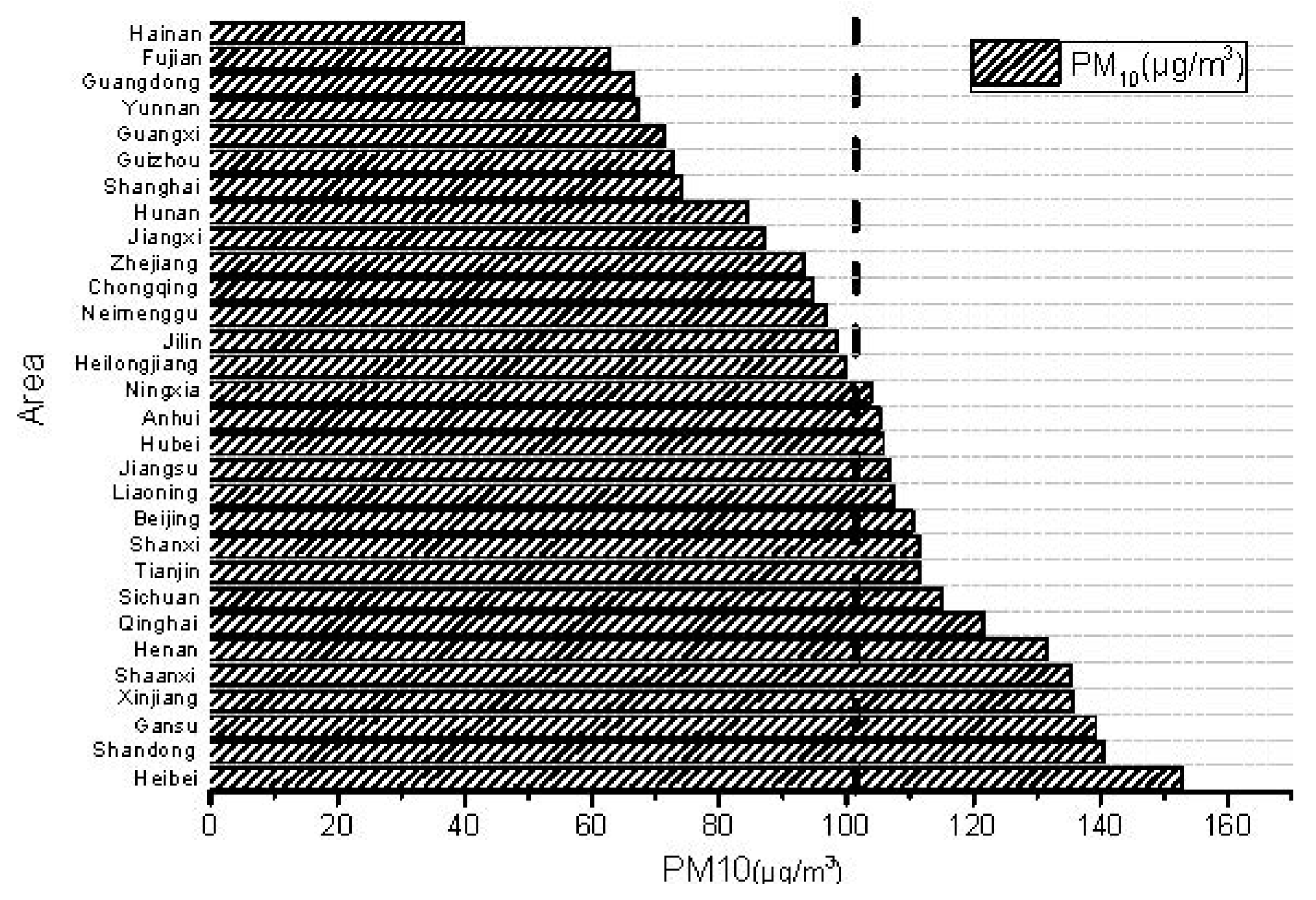
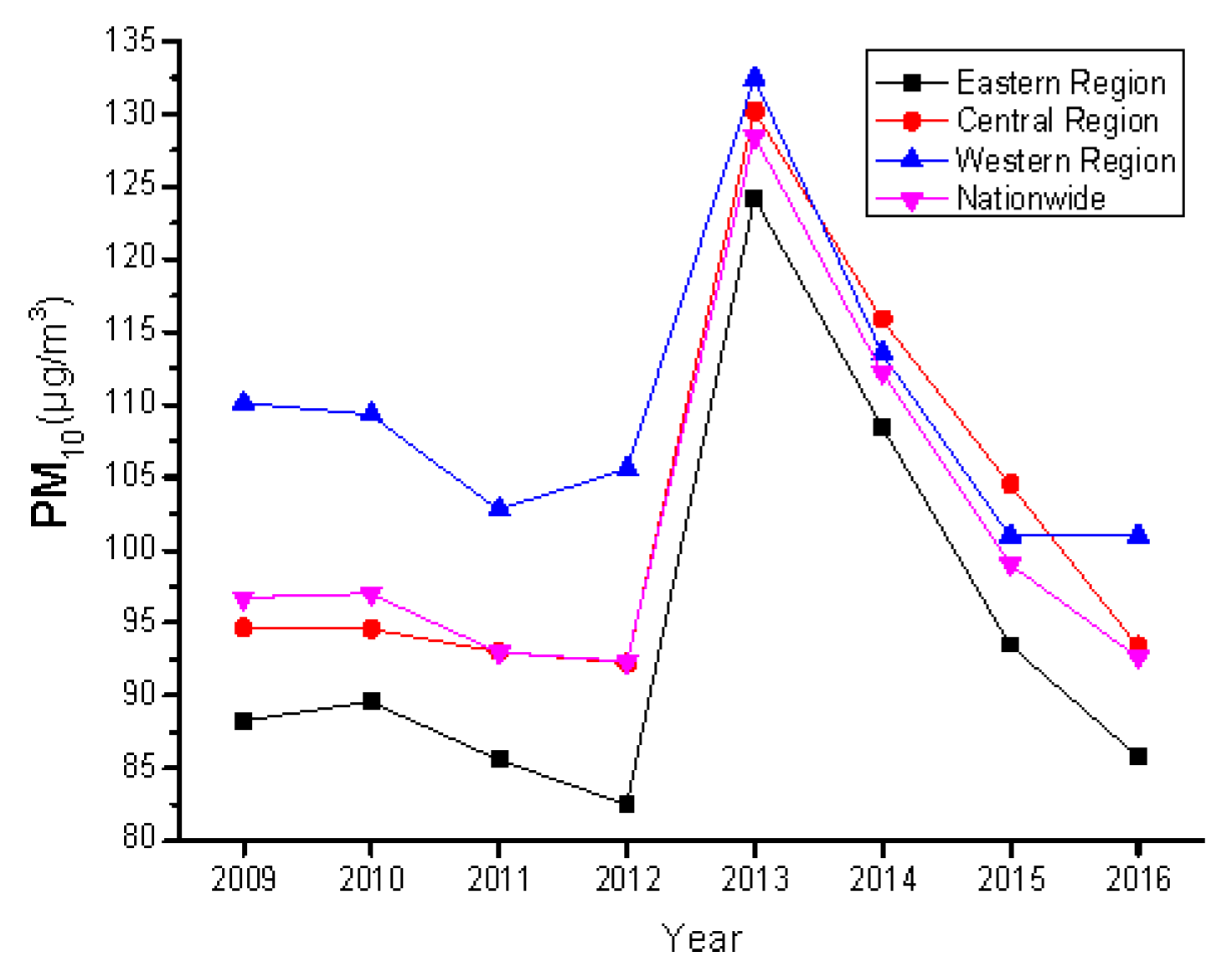
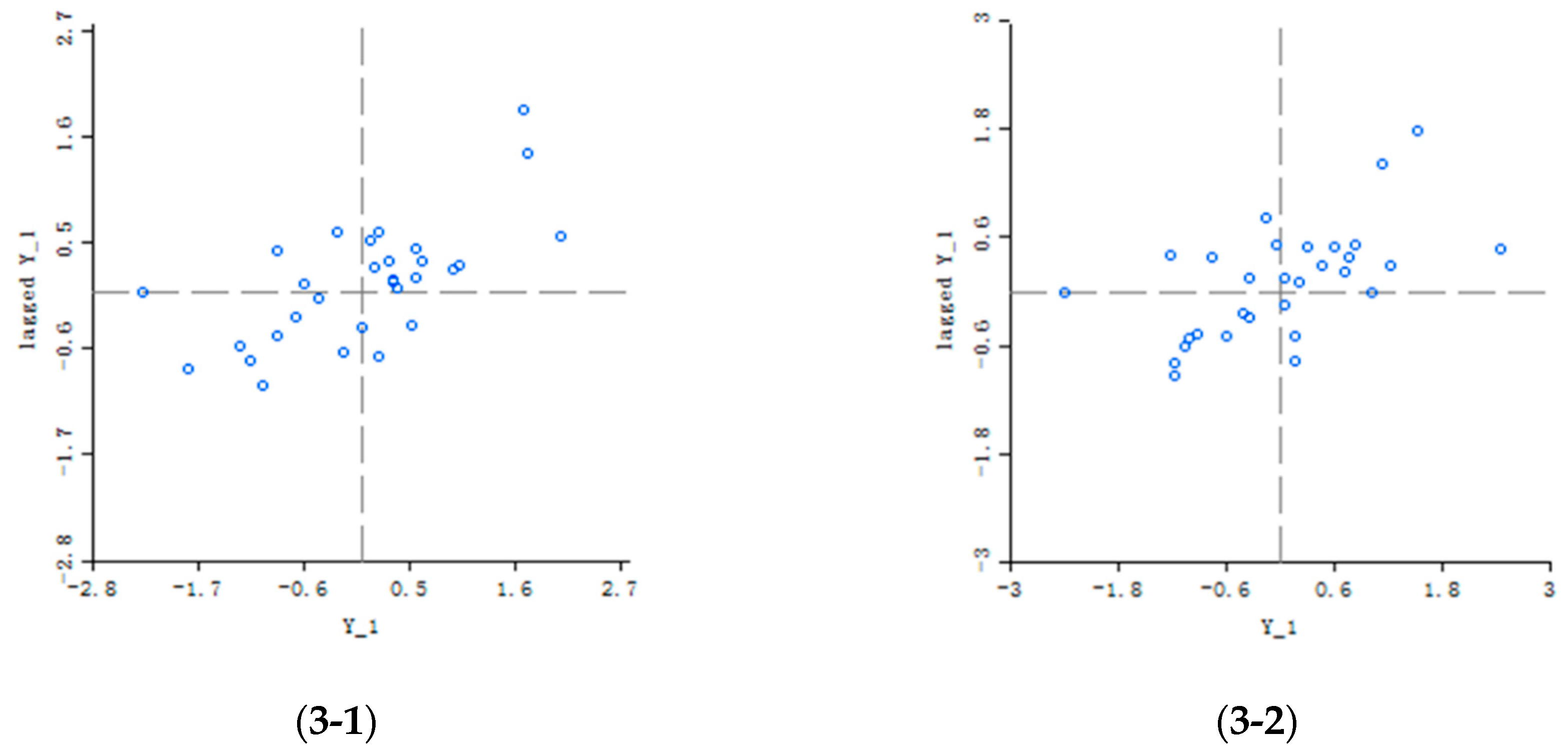
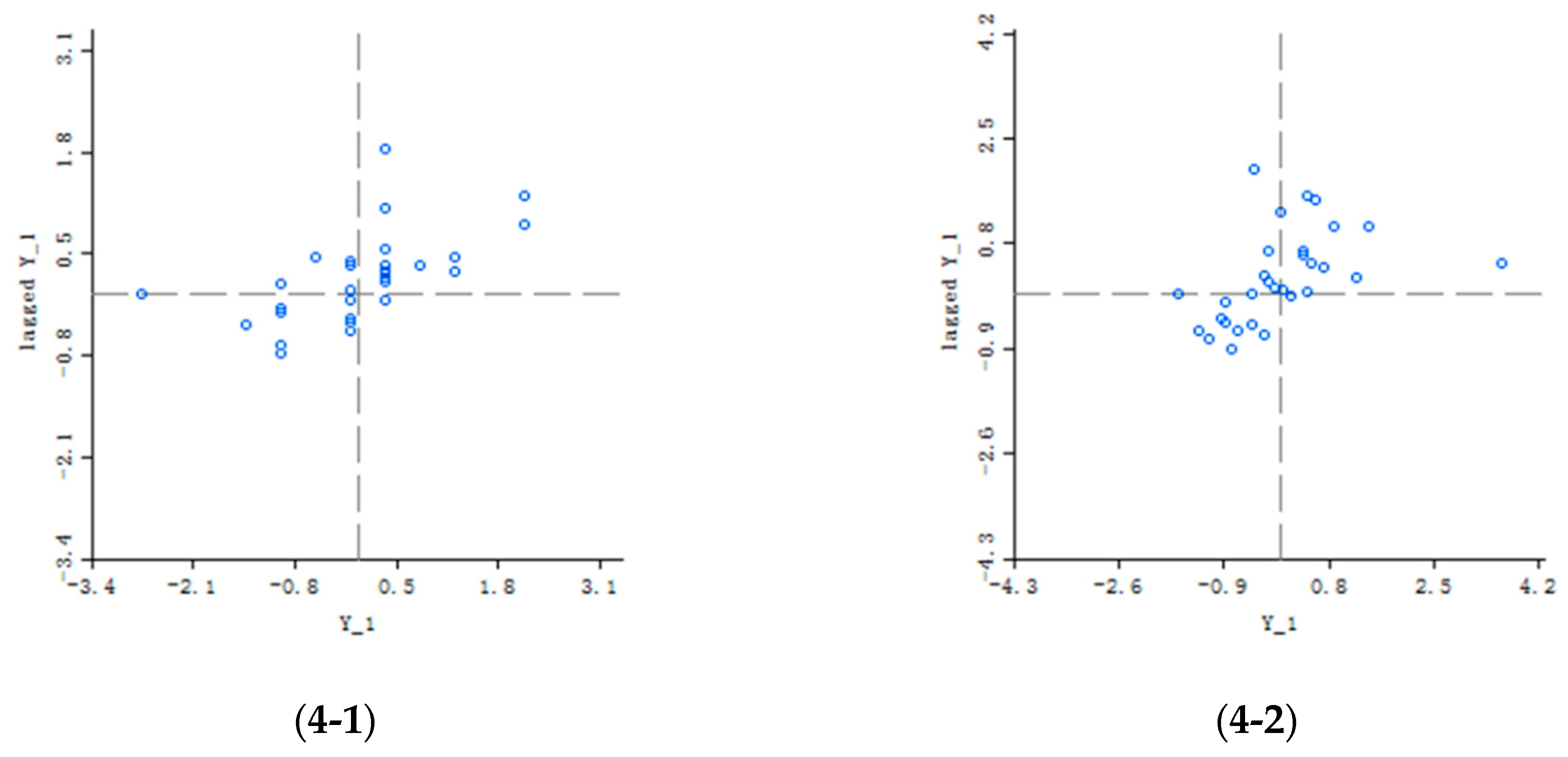
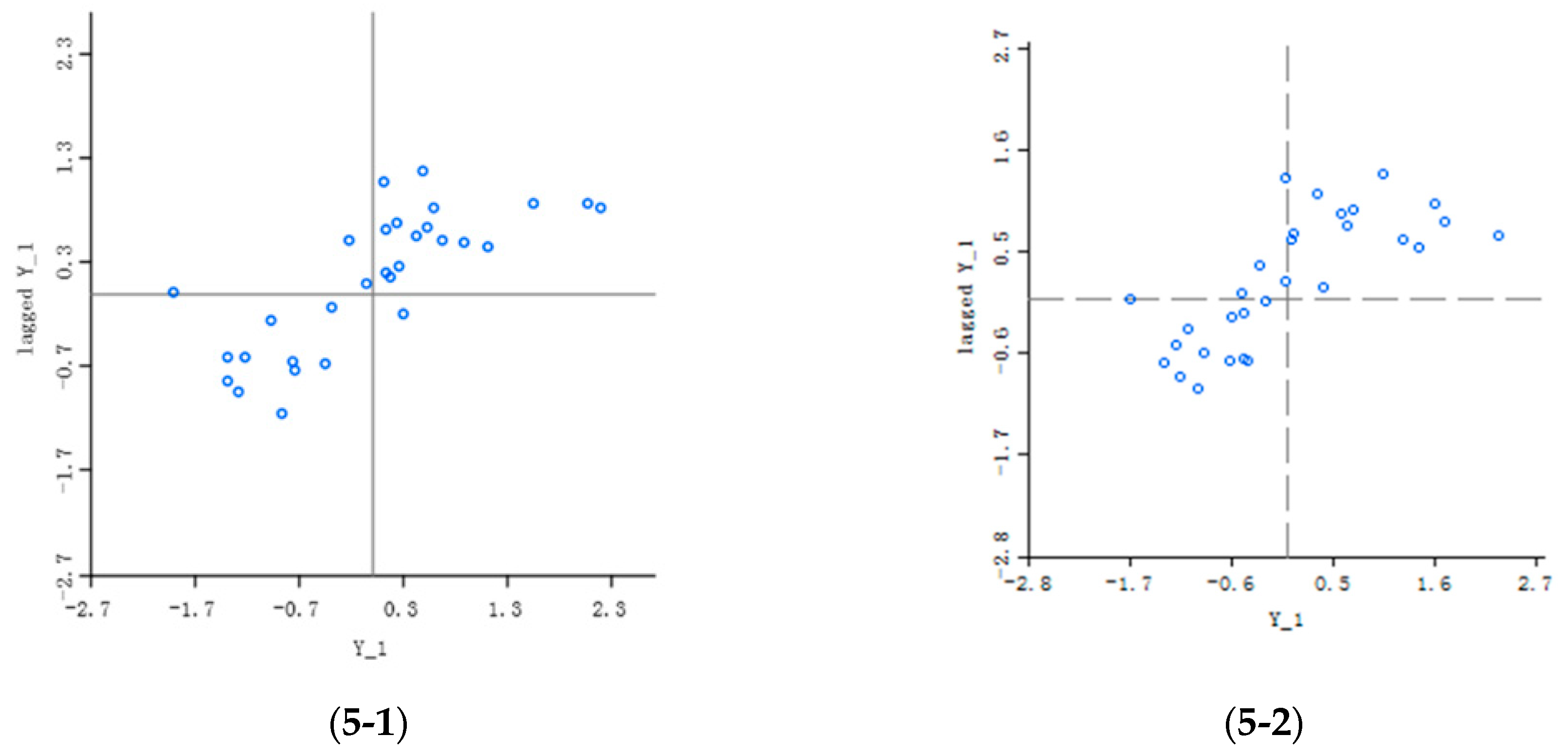
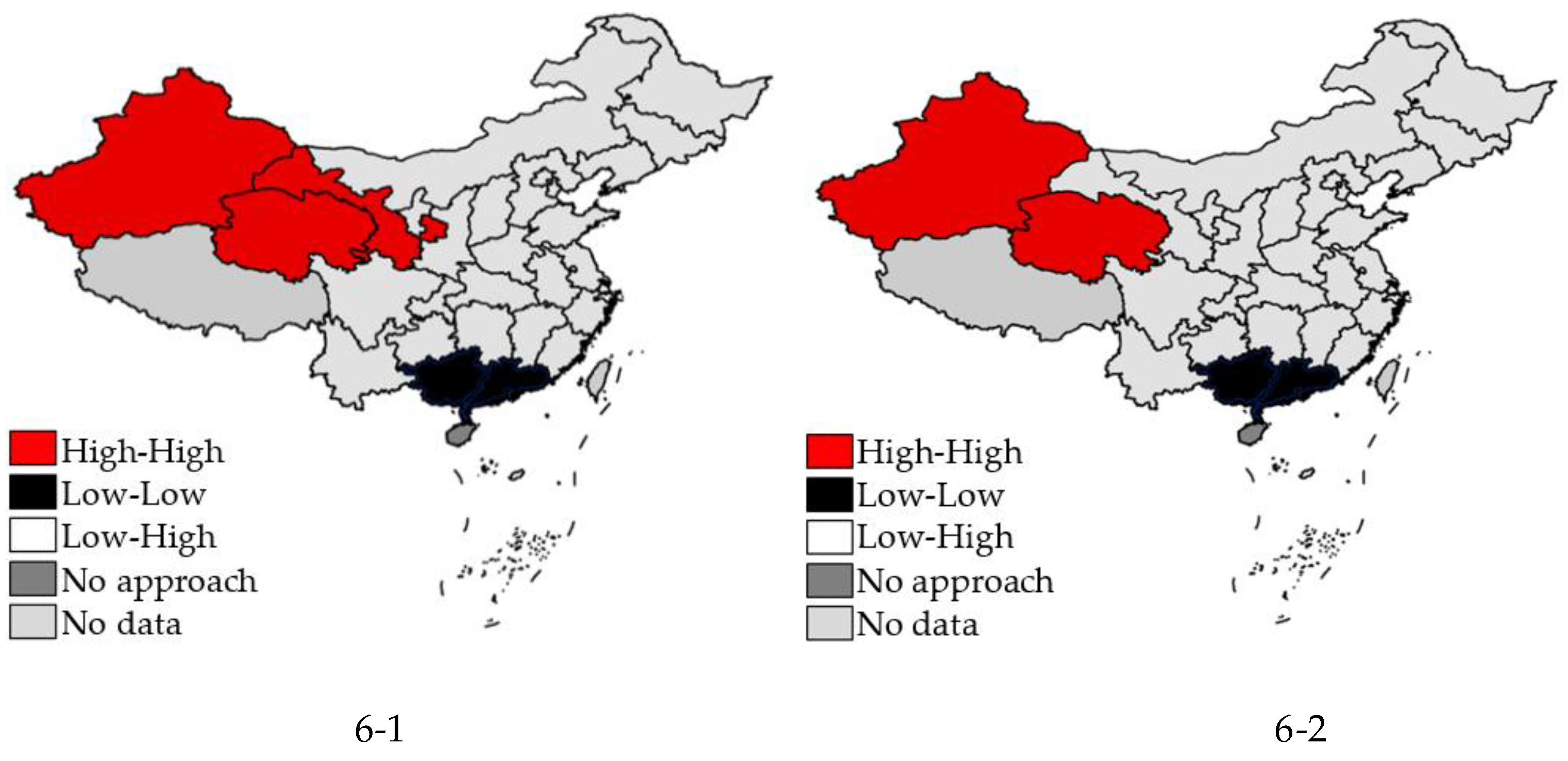
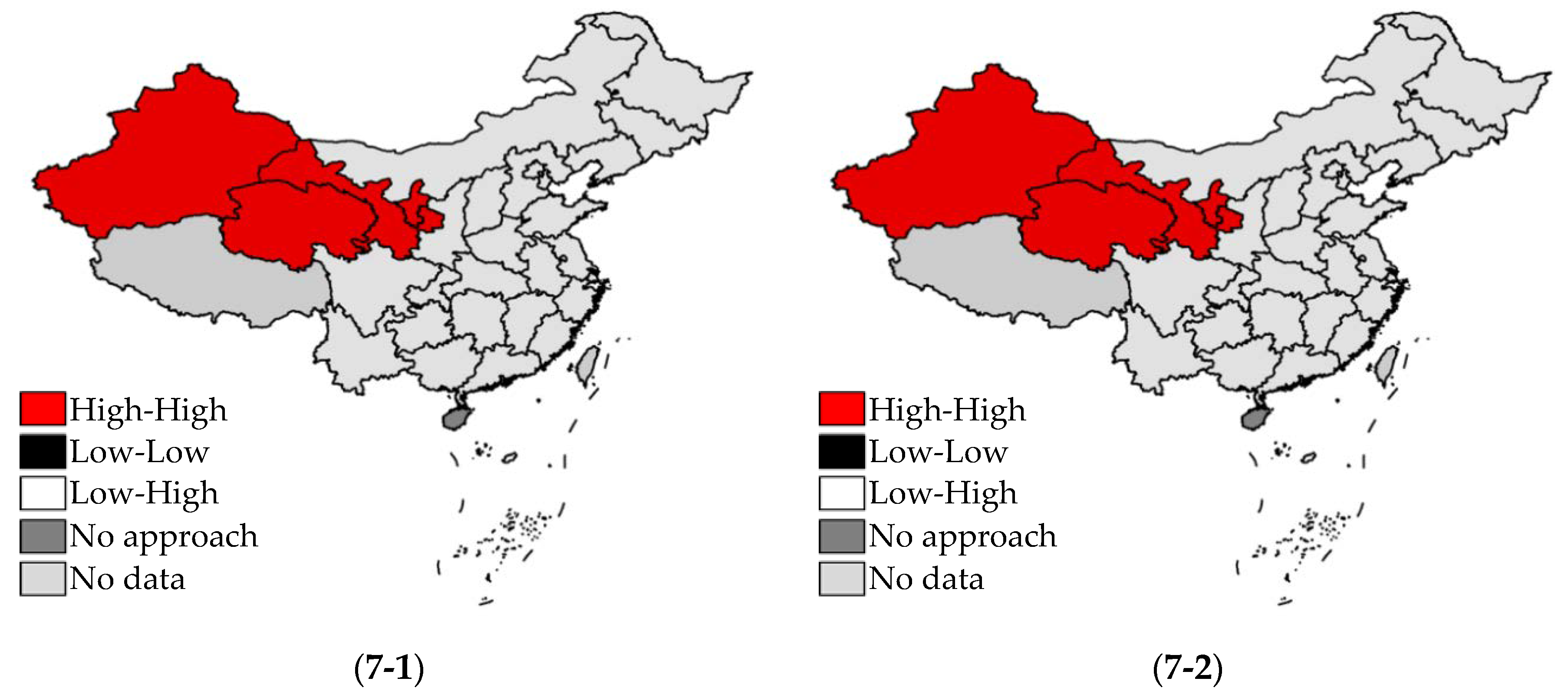
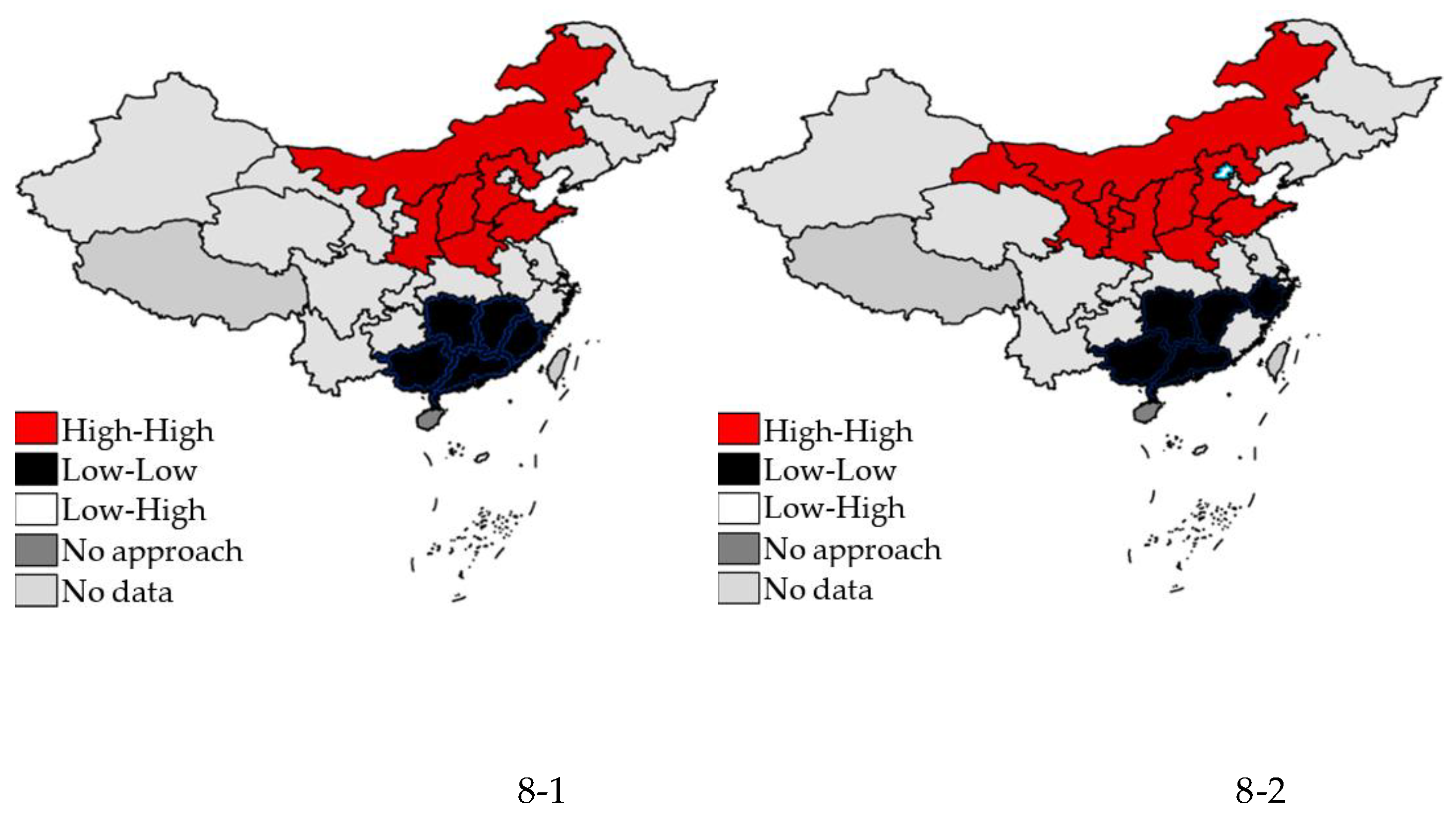
| Variable | Mean Value | Standard Deviation | Minimum Value | Maximum Value | Sample Size |
|---|---|---|---|---|---|
| Y | 101.4375 | 32.8792 | 30 | 305 | 240 |
| GDP | 9.458897 | 0.8778152 | 6.985891 | 11.1806 | 240 |
| STR | 0.4653963 | 0.0814997 | 0.192622 | 0.590454 | 240 |
| INO | 9.569058 | 1.494218 | 5.575949 | 12.50597 | 240 |
| ENE | 0.9683548 | 0.5347534 | 0.2835 | 3.45 | 240 |
| URB | 54.76021 | 13.09387 | 29.89 | 89.6 | 240 |
| CAR | 0.0920264 | 0.0474182 | 0.024161 | 0.251928 | 240 |
| Years | Moran’s I | P |
|---|---|---|
| 2009 | 0.4181 | 0.001 |
| 2010 | 0.3525 | 0.002 |
| 2011 | 0.3345 | 0.001 |
| 2012 | 0.3237 | 0.002 |
| 2013 | 0.3476 | 0.001 |
| 2014 | 0.4971 | 0.001 |
| 2015 | 0.5060 | 0.001 |
| 2016 | 0.5232 | 0.001 |
| Variable | Statistic | p Value |
|---|---|---|
| Moran’I | 1.699 | 0.0450 |
| LM_spatial_lag | 66.936 *** | 0.000 |
| Robust_LM_spatial_lag | 1.141 | 0.285 |
| LM_spatial_err | 70.015 ** | 0.000 |
| Robust_LM_spatial_err | 4.220 ** | 0.040 |
| Variable | SLM | SEM | ||||||
|---|---|---|---|---|---|---|---|---|
| Unfixed Effect Model | Fixed-Time Effect Model | Space Fixation Effect Model | Space−Time Fixation Effect Model | Unfixed Effect Model | Fixed-Time Effect Model | Space Fixation Effect Model | Space−Time Fixation Effect Model | |
| GDP | 0.045 | 0.049 | −0.529 ** | −0.742 * | 0.032 | 0.059 | −0.537 ** | −0.724 * |
| (0.50) | (0.93) | (−2.27) | (−1.75) | (0.35) | (1.10) | (−1.96) | (−1.71) | |
| STR | 0.932 *** | 1.110 *** | 0.512 | 0.187 | 0.909 ** | 1.169 *** | 0.357 | 0.204 |
| (2.62) | (4.20) | (1.23) | (0.34) | (2.33) | (4.27) | (0.73) | (0.37) | |
| INO | −0.028 | 0.013 | 0.012 | 0.012 | 0.001 | 0.008 | 0.031 | 0.015 |
| (−0.58) | (0.40) | (0.19) | (0.18) | (0.01) | (0.24) | (0.47) | (0.22) | |
| ENE | 0.073 | 0.143 *** | −0.024 | −0.014 | 0.068 | 0.144 *** | 0.021 | −0.009 |
| (1.21) | (2.64) | (−0.34) | (−0.18) | (1.05) | (2.65) | (0.28) | (−0.12) | |
| URB | −0.005 | −0.009 *** | 0.012 | 0.017 | −0.008 * | −0.009 *** | 0.013 | 0.016 |
| (−1.47) | (−4.17) | (1.20) | (1.55) | (−1.91) | (−4.06) | (1.26) | (1.50) | |
| CAR | 2.471 *** | 4.045 *** | 3.155 *** | 3.401 ** | 3.669 *** | 4.031 *** | 3.492 *** | 3.387 ** |
| (3.64) | (6.34) | (2.68) | (2.53) | (3.94) | (6.29) | (2.91) | (2.52) | |
| ρ/λ | 0.750 *** | 0.118 | 0.788 ** | 0.238 | 0.776 *** | −0.162 | 0.786 *** | 0.199 |
| (11.77) | (0.52) | (13.94) | (1.14) | (12.99) | (−0.54) | (14.14) | (0.88) | |
| R2 | 0.229 | 0.259 | 0.006 | 0.009 | 0.247 | 0.261 | 0.003 | 0.008 |
| Log Likelihood | 41.860 | −12.736 | 101.004 | 111.2679 | 44.604 | −12.708 | 101.611 | 111.028 |
| N | 240 | 240 | 240 | 240 | 240 | 240 | 240 | 240 |
© 2019 by the authors. Licensee MDPI, Basel, Switzerland. This article is an open access article distributed under the terms and conditions of the Creative Commons Attribution (CC BY) license (http://creativecommons.org/licenses/by/4.0/).
Share and Cite
Hou, J.; Zhang, S.; Song, H.; Li, F. Spatial–Temporal Heterogeneous Evolution of Haze Pollution in China as Deduced with the Use of Spatial Econometrics. Sustainability 2019, 11, 7058. https://doi.org/10.3390/su11247058
Hou J, Zhang S, Song H, Li F. Spatial–Temporal Heterogeneous Evolution of Haze Pollution in China as Deduced with the Use of Spatial Econometrics. Sustainability. 2019; 11(24):7058. https://doi.org/10.3390/su11247058
Chicago/Turabian StyleHou, Jian, Shuang Zhang, Hongfeng Song, and Fengshu Li. 2019. "Spatial–Temporal Heterogeneous Evolution of Haze Pollution in China as Deduced with the Use of Spatial Econometrics" Sustainability 11, no. 24: 7058. https://doi.org/10.3390/su11247058
APA StyleHou, J., Zhang, S., Song, H., & Li, F. (2019). Spatial–Temporal Heterogeneous Evolution of Haze Pollution in China as Deduced with the Use of Spatial Econometrics. Sustainability, 11(24), 7058. https://doi.org/10.3390/su11247058





